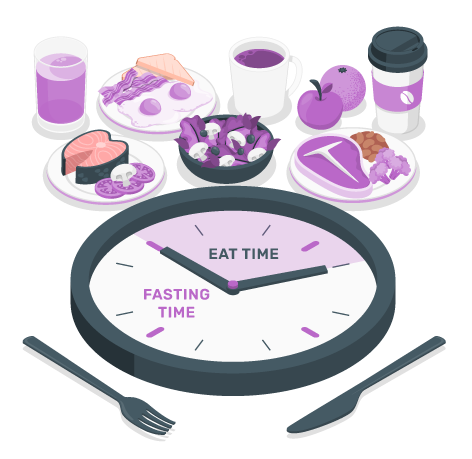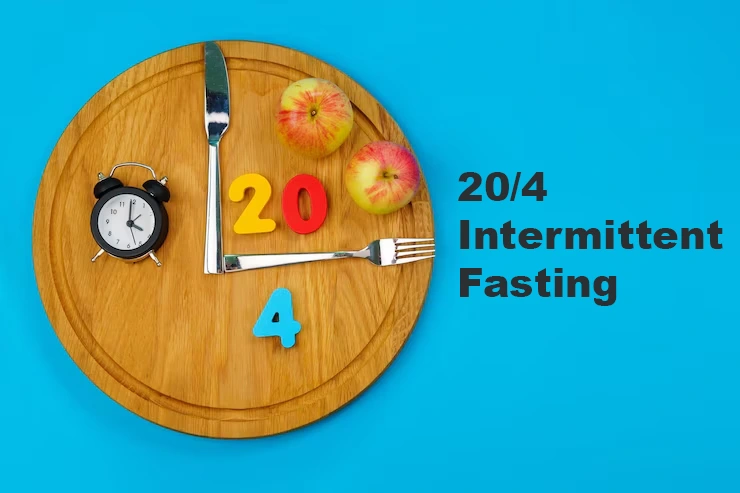Imagine you've committed to intermittent fasting. You're ready to skip late-night snacks, you're determined to shed a few pounds, and you're even excited about the potential energy boost.
But here's the problem: when exactly should you start and stop eating? Doing the math every single day is exhausting. That's where an intermittent fasting calculator comes in, it's like having a digital timekeeper that does all the hard work for you. Just enter your start time and preferred fasting method, and it gives you the exact hours for fasting and eating.
In this guide, we'll walk you through:
By the end, you'll know how to use this tool effectively to transform your health journey, without confusion or complicated math.
At its core, an intermittent fasting calculator is a simple but powerful tool that removes the guesswork from fasting.
Here's what it does:
For example, if you choose the 16:8 fasting method and set your fasting start time at 9 PM, the calculator instantly tells you that:
No mental math. No confusion. Just clarity.
Intermittent fasting isn't a rigid plan, it's a flexible lifestyle that adapts to your schedule. People fast in different ways depending on their goals, energy levels, and daily routines. The beauty of using an intermittent fasting calculator is that it takes the guesswork out of timing, helping you stick to whichever style you choose. Here are the most practiced fasting methods, explained:

Fasting Window: 12 hours
Eating Window: 12 hours
Example: Eat from 8 AM to 8 PM, then fast overnight until breakfast.
This is the simplest way to begin fasting since half of your fast happens while you're asleep. It gently introduces your body to time-restricted eating without making you feel deprived. Beginners often find this the most sustainable entry point before moving on to longer fasting windows.
Fasting Window: 16 hours
Eating Window: 8 hours
Example: Fast from 8 PM to 12 PM the next day, and eat between 12 PM and 8 PM.
Loved by millions worldwide, the 16:8 approach strikes the perfect balance between effectiveness and sustainability. It's long enough to trigger fat-burning benefits yet short enough to still enjoy satisfying meals. The calculator ensures you never lose track of your fasting or eating hours.
Fasting Window: 18 hours
Eating Window: 6 hours
Example: Eat between 1 PM and 7 PM only.
If you've mastered 16:8 and want to push further, 18:6 is a natural progression. The longer fasting window gives your digestive system more rest and may accelerate fat loss. It works well for people who don't mind skipping breakfast and prefer larger, filling meals later in the day.

Fasting Window: 20 hours
Eating Window: 4 hours
Example: Eat from 4 PM to 8 PM.
Inspired by ancient warrior eating patterns, this method demands discipline. You'll spend most of the day fasting, with a small 4-hour window to fuel up. It's often chosen by advanced fasters looking for sharper metabolic benefits and a minimalist eating schedule. Learn more about the 20:4 intermittent fasting method and whether it's right for your lifestyle.
Fasting Window: 23 hours
Eating Window: 1 hour
Example: One big meal at dinner time.
OMAD is one of the strictest forms of intermittent fasting, allowing only a single meal each day. While it can deliver rapid results, it's not suitable for everyone, especially beginners. A calculator is essential here because timing becomes critical, you need to know exactly when your fasting and eating windows start and end.
Routine: Eat normally for 5 days a week, then restrict calories (around 500–600) on 2 non-consecutive days.
Unlike daily fasting windows, the 5:2 method focuses on weekly calorie reduction. It's popular among people who want flexibility without daily restrictions. The calculator helps you plan which days to fast lightly so you can maintain consistency.
Routine: Eat normally one day, then fast (or eat very few calories) the next day.
ADF is one of the most challenging methods because it requires you to alternate between fasting and eating days. While effective for weight loss and metabolic health, it takes strong willpower. With a fasting calculator, you can track fasting and eating days in advance, making the process less overwhelming.
Here is a simple table for an intermittent fasting diet plan, covering a typical week with a 16:8 fasting/eating window:
| Day | Fasting Period | Eating Period | Meal 1 (Start of eating window) | Meal 2 (Mid-Eating Window) | Meal 3 (End of eating window) | Snacks and beverages |
|---|---|---|---|---|---|---|
| Monday | 8 PM - 12 PM | 12 PM - 8 PM | Grilled chicken salad | Greek yogurt with nuts and berries | Baked salmon with quinoa | Herbal tea, water, nuts |
| Tuesday | 8 PM - 12 PM | 12 PM - 8 PM | Turkey wrap with veges | Apple slices with peanut butter | Stir-fried tofu with vegetables | Green tea, water, carrot sticks |
| Wednesday | 8 PM - 12 PM | 12 PM - 8 PM | Avocado toast with eggs | Smoothie with yogurt, banana, spinach and ginger | Grilled shrimp with brown rice | Herbal tea, water, mixed nuts |
| Thursday | 8 PM - 12 PM | 12 PM - 8 PM | Quinoa bowl with chickpeas | Cottage cheese with pineapple | Chicken stir fry with broccoli | Green tea, water, nuts, celery sticks |
| Friday | 8 PM - 12 PM | 12 PM - 8 PM | Tuna salad with whole grain cracker | Hummus with veges sticks | Baked cod with sweet potato | Green tea, water, almonds |
| Saturday | 8 PM - 12 PM | 12 PM - 8 PM | Lentil soup with whole grain bread | Cheese and whole wheat crackers | Beef stir-fry with peppers | Water, herbal tea, fruit slices |
| Sunday | 8 PM - 12 PM | 12 PM - 8 PM | Egg and veges scramble | Protein shake with spinach | Grilled chicken with wild rice | Green tea, trail mix |
Sure, you can do the math manually, but why waste energy when a tool can do it instantly? Here are the main benefits:
Research has shown that intermittent fasting isn't just about skipping meals, it impacts your body at a cellular and hormonal level.
One notable clinical trial on intermittent fasting, conducted by researchers at Johns Hopkins University, examined the effects of time-restricted eating (TRE) on weight loss and metabolic health.
The trial involved 41 adults with obesity and prediabetes, who were randomly assigned to either a 10-hour eating window or a regular eating pattern over 12 weeks. Both groups consumed the same number of calories daily. The study found that both groups lost similar amounts of weight, suggesting that the timing of meals may not be as critical as the overall calorie intake for weight loss.
For more detailed information about intermittent fasting research, you can visit PubMed for peer-reviewed studies.
Intermittent fasting sounds simple, you just skip meals and watch the clock. But when beginners dive in without proper guidance, they often face challenges that could have been avoided. Here are the most common mistakes and why they can sabotage your progress:
Many beginners treat the eating window as a chance to binge. Overeating cancels out the calorie deficit and slows progress. Stick to balanced, portion-controlled meals instead.
Skipping hydration often leads to fatigue, headaches, and cravings. Since food also provides fluids, drink plenty of water, black coffee, or unsweetened tea during fasting.
Jumping straight into 20:4 or OMAD is too harsh for most beginners. Start with easier schedules like 12:12 or 16:8 to allow your body to adapt.
Eating unhealthy foods just because they "fit the window" undermines fasting. Prioritize nutrient-dense meals with protein, fiber, and healthy fats.
Intermittent fasting isn't a quick fix. Real results appear over weeks, not days, so consistency and patience are key.
Not everyone should fast. You should avoid or consult your doctor if you are:
The calculator helps you set your fasting start time and automatically shows when your eating window begins and ends. It removes the guesswork and keeps you consistent.
The 16:8 method is the most popular and beginner-friendly. It balances effectiveness with sustainability, making it easier to stick with long term.
Yes! In fact, staying hydrated is essential. You can drink water, black coffee, and unsweetened tea during fasting hours without breaking your fast.
Intermittent fasting can support weight loss by reducing calorie intake and improving metabolism. However, results depend on consistency and eating balanced meals during your window.
Yes, light to moderate exercise is usually fine during fasting. Some people even find it boosts fat burning. But listen to your body and avoid overexertion, especially in the beginning.
No. It may not be safe for pregnant or breastfeeding women, children, underweight individuals, people with eating disorders, or those with certain medical conditions. Always consult a doctor first.
Most people notice changes in 2–4 weeks, but results vary. Consistency, diet quality, and lifestyle habits all play a role.
Yes, the calculator allows flexibility. You can adjust your fasting start time based on your schedule, but sticking to a routine usually brings better results.
Focus on whole, nutrient-dense foods like lean proteins, vegetables, fruits, healthy fats, and whole grains. Avoid processed junk food, which can slow your progress.
No, when done correctly, intermittent fasting can actually boost metabolic flexibility. Extreme restriction or long-term under eating, however, may slow it down.
Below is a reference list for the article on intermittent fasting:
